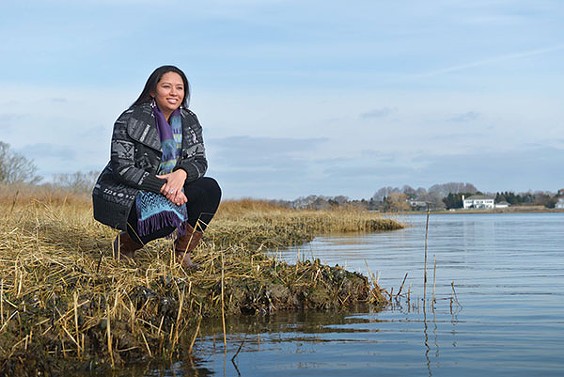
Right now, indigenous people are a greater part of our national discourse than in recent years. But despite this progress, Kelsey Leonard, a Pittsburgh-based indigenous-people’s rights advocate and attorney for indigenous people’s rights, says the impact that will have is uncertain.
Leonard is part of the Shinnecock Nation, a tribe native to eastern Long Island, N.Y. She spent her early years in Pittsburgh, where her mother was involved with the Council of Three Rivers American Indian Center. And she says her life growing up in Pennsylvania was a bit difficult, because she was a “sort of ultra minority” in the state. Still, she felt inspired by her mother’s work advocating for Native Americans.
Leonard was the first Native American graduate of Oxford University in England and received her law degree from Duquesne University. She is currently a tribal leader in the National Ocean Council, and this month was named to the 2016 “Native American 40 Under 40” class by the National Center for American Indian Enterprise Development.
With the ongoing land-use fight in Standing Rock, N.D., over the Dakota Access Pipeline, Pittsburgh City Paper spoke to Leonard by phone about indigenous people’s rights in Western Pennsylvania, the U.S. and North America.
What is the Native-American community like in Pittsburgh?
There is actually a really long history of Native Americans in Southwestern Pennsylvania. When a lot of tribes were terminated, they were given one-way tickets to urban areas and Pittsburgh was one of those cities they arrived in. Allegheny National Forest’s tribes were forcefully removed with the construction of the Kinzua Dam, and many came to Pittsburgh. But they did not have any social support when they got into the city. There was no job training, there was no educational outreach. Then, the Urban Indian Center was built to cultivate those programs.
For me, coming in 30 years after they had started, it’s a really vibrant and diverse community. You interact with many tribal nations all around the country, even from Canada. It’s a really unique community. You get to learn from all these different indigenous cultures, with some commonality, but there is also a lot of beauty in their diversity.
Why should Pittsburghers care about Native-American rights and things like the Dakota Access Pipeline?
It’s a basic level of human decency, what is currently happening in Standing Rock. We often put up these qualifiers, like it’s an environmental-justice issue. It’s really not; it’s a justice issue and basic human-rights issues. Shooting water cannons at protesters in freezing weather is a human-rights violation. If those rights can be infringed on in North Dakota, then it is a violation for all of us.
But it’s also a level of culpability. It’s ironic that we are celebrating Thanksgiving this week, because [it reminds us] how indigenous peoples were the reason early settlers survived. Our humility and our graciousness were keys to early settlers’ survival. And to now see people be bombarded with concussion grenades and water cannons and rubber bullets, in their peaceful protests to protect their waters, is a disgrace. As Americans, we all need to be conscious of the processes of colonization that is ongoing against indigenous people in this land.
In the last few years, in addition to Standing Rock, protests have taken place in Oak Flats, in Arizona, and Bear Butte, in South Dakota. Are we on the precipice of a large-scale Native-American-rights social movement?
It’s still undetermined the weight and the gravity that these movements will have. A lot of it is based on people joining and putting their minds and bodies on the line, but it is also predicated on the type of political administration that we have. With the change in the administration, it is questionable what will happen.
There is precedent in United States history for the issuing of extermination orders for indigenous people. Militarized police response in Standing Rock is getting very, very close to extermination orders. And there have been comparisons between President-elect Trump and Andrew Jackson, and Jackson is the president who issued those extermination orders.
What type of movement will this be? I don’t know. I can confidently say that President Obama is not someone who would issue extermination orders, but I can’t say that about Trump. And that is a scary thing.
How can Pittsburghers contribute to Native American causes?
We can all acknowledge where our money is. Kelcy Warren, the CEO of Energy Transfer Partners, is fully confident that his pipeline is going to go through and that’s because he made large contributions to President-elect Trump’s campaign. And Trump has [hundreds of thousands] invested in [the companies that own] the Dakota Access Pipeline. That is a gross level of conflict of interest.
But it speaks to fact that, as Americans and even indigenous people, we need to be conscious of where our money is. You have to look at your 401(k) or your pension. If you are in the Vanguard 500, it’s likely some of your investment is going to pipelines. One of the largest investors in the Dakota pipeline is actually the Pennsylvania teachers’ fund. [Records show that the Pennsylvania Public Schools Retirement System owns most of the 5 million Equity Transfer Partners shares that belong to the state.] Things like that are where we can address our individual culpability.
For those wishing to donate to the Dakota Access Pipeline protest efforts, Leonard suggests donating directly to the Standing Rock Sioux Tribe at standwithstandingrock.net.














